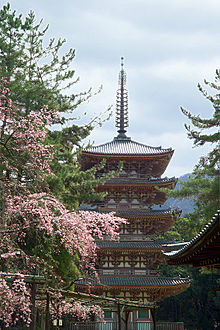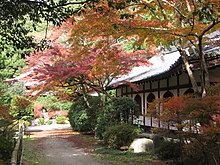Daigo-ji

Daigo-ji (醍醐寺, Daigo-ji) is a Shingon Buddhist temple in Fushimi-ku, Kyoto, Japan. The main image (honzon) is Yakushi.
History
Daigo-ji was founded in the early Heian period.[1] In 874, Rigen-daishi (Shōbō) founded the temple.
- Enchō 8, 22nd day of the 9th month (930): Emperor Daigo fell ill and then abdicated.[2]
- Enchō 8, 29th day of the 9th month (930): Emperor Daigo entered the Buddhist priesthood in the very early morning hours. As a monk, he took the Buddhist name Hō-kongō; and shortly thereafter, died at the age of 46.[3] This monk was buried in the precincts of Daigo-ji, which is why the former-emperor's posthumous name became Daigo-tennō.[4]
National treasures
Several structures, including the kondō and the five-story pagoda, are National Treasures of Japan.
Daigo-ji possesses 18 specifically-designated national treasures, including the buildings and other works as well; and the temple holds several dozen important cultural assets.
Daigo-ji is part of the "Historic Monuments of Ancient Kyoto" World Heritage Site.
The five-story pagoda at Daigoji temple was built in 951 and is the oldest building in Kyoto. It was one of few buildings to survive the Onin War in the 1400s.
Garden

More than seven centuries after its founding, Toyotomi Hideyoshi held a famous cherry-blossom-viewing party in 1598 at the Sambō-in sub-temple.[5]
The bright colors of maple leaves attract tourists and others in the Autumn season. Emperor Suzaku's mausoleum, known as Daigo no misasagi, is located near Daigo-ji.
Events

On August 24, 2008, the Juntei Kannon-dō at the top of the hill on the east of the temple burned. It stood in the Kami Daigo part of the temple. Kami Daigo is Number 11 in the 33 temples of the Kansai Kannon Pilgrimage. The structure dated from 1968.[6]
See also
- List of Buddhist temples in Kyoto
- List of National Treasures of Japan (temples)
- List of National Treasures of Japan (ancient documents)
- List of National Treasures of Japan (paintings)
- List of National Treasures of Japan (sculptures)
- List of National Treasures of Japan (writings)
- For an explanation of terms concerning Japanese Buddhism, Japanese Buddhist art, and Japanese Buddhist temple architecture, see the Glossary of Japanese Buddhism.
Notes
- ^ Ponsonby-Fane, Richard. (1956). Kyoto: The Old Capital of Japan, 794-1869, p. 115.
- ^ Brown, Delmer et al. (1979). Gukanshō, p. 293.
- ^ Titsingh, Isaac. (1834). Annales des empereurs du Japon, p. 134; Brown, p. 292.
- ^ Titsingh, p. 134.
- ^ Main, Alison. (2002). The Lure of the Japanese Garden, p. 27.
- ^ NHKニュース 京都 醍醐寺の観音堂が全焼 Retrieved August 24, 2008
References
- Brown, Delmer and Ichiro Ishida, eds. (1979). [ Jien, 1221], Gukanshō; "The Future and the Past: a translation and study of the 'Gukanshō,' an interpretive history of Japan written in 1219" translated from the Japanese and edited by Delmer M. Brown & Ichirō Ishida. Berkeley: University of California Press. ISBN 0-520-03460-0
- Ponsonby-Fane, Richard Arthur Brabazon. (1956). Kyoto: The Old Capital of Japan, 794-1869. Kyoto: The Ponsonby Memorial Society.
- Titsingh, Isaac. (1834). [Siyun-sai Rin-siyo/Hayashi Gahō, 1652]. Nipon o daï itsi ran; ou, Annales des empereurs du Japon. Paris: Oriental Translation Society of Great Britain and Ireland.
- Varley, H. Paul , ed. (1980). Kitabatake Chikafusa, 1359], Jinnō Shōtōki ("A Chronicle of Gods and Sovereigns: Jinnō Shōtōki of Kitabatake Chikafusa" translated by H. Paul Varley). New York: Columbia University Press. ISBN 0-231-04940-4
34°57′05″N 135°49′15″E / 34.95139°N 135.82083°E
</ref>

